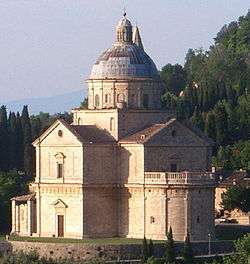Montepulciano
| Montepulciano | ||
|---|---|---|
| Comune | ||
| Comune di Montepulciano | ||
|
Panorama of Montepulciano | ||
| ||
 Montepulciano Location of Montepulciano in Italy | ||
| Coordinates: IT 43°06′N 11°47′E / 43.100°N 11.783°E | ||
| Country | Italy | |
| Region | Tuscany | |
| Province / Metropolitan city | Siena (SI) | |
| Frazioni | Abbadia, Acquaviva, Argiano, Ascianello, Cervognano, Fonte al Giunco, Gracciano, Montepulciano Stazione, Nottola, Salcheto, Sant'Albino, Tre Berte, Valiano | |
| Government | ||
| • Mayor | Andrea Rossi (PD) | |
| Area | ||
| • Total | 165.58 km2 (63.93 sq mi) | |
| Elevation | 605 m (1,985 ft) | |
| Population (31 July 2014) | ||
| • Total | 14,324 | |
| • Density | 87/km2 (220/sq mi) | |
| Demonym(s) | Poliziani or Montepulcianesi | |
| Time zone | CET (UTC+1) | |
| • Summer (DST) | CEST (UTC+2) | |
| Postal code | 53045 | |
| Dialing code | 0578 | |
| Patron saint | St. John the Baptist | |
| Saint day | August 29 | |
| Website | Official website | |



Montepulciano (Italian: [ˌmontepulˈtʃaːno]) is a medieval and Renaissance hill town and comune in the Italian province of Siena in southern Tuscany. It sits high on a 605-metre (1,985 ft) limestone ridge, 13 kilometres (8 mi) east of Pienza, 70 kilometres (43 mi) southeast of Siena, 124 kilometres (77 mi) southeast of Florence, and 186 kilometres (116 mi) north of Rome by car.
Montepulciano is a major producer of food and drink. Renowned for its pork, cheese, "pici" pasta, lentils, and honey, it is known worldwide for its wine. Connoisseurs consider its Vino Nobile, which should not be confused with varietal wine merely made from the Montepulciano grape, among Italy's best.
History
According to legend, it was founded by the Etruscan King Lars Porsena of Chiusi; recent findings prove that a settlement was already in existence in the 4th-3rd centuries BC. In Roman times it was the seat of a garrison guarding the main roads of the area.
After the fall of the Western Roman Empire, it developed as a religious center under the Lombards. In the 12th century it was repeatedly attacked by the Republic of Siena, which the Poliziani faced with the help of the Perugia and Orvieto, and sometimes Florence, communes. The 14th century was characterized by constant struggles between the local noble families, until the Del Pecora family became rulers of the town. From 1390, Montepulciano was a loyal ally (and later possession) of Florence and, until the mid-16th century, lived a period of splendour with architects such as Antonio da Sangallo the Elder, Jacopo Barozzi da Vignola, Baldassarre Peruzzi, Ippolito Scalza and others, building luxurious residences and other edifices here. In 1559, when Siena was conquered by Florence and Montepulciano lost its strategic role, its importance declined.
After the unification of Italy and the drying of the Val di Chiana, the town remained the most important agricultural centre in the area, while the industrial activities moved mostly next to Chiusi, which was nearer to the railroad being built in that period.
A competitive "barrel race through the city" called the Bravio delle botti has been held on the last Sunday of August since the 14th Century.
Main sights
The main street of Montepulciano stretches for 1.5 kilometres (0.9 mi) from the Porta al Prato to the Piazza Grande at the top of the hill. The city is renowned for its walkable, car-free nature.
The main landmarks include:
- The Palazzo Comunale, designed by Michelozzo in the tradition of the Palazzo della Signoria (Palazzo Vecchio) of Florence.
- Palazzo Tarugi, attributed to Antonio da Sangallo the Elder or Jacopo Barozzi da Vignola. It is entirely in travertine, with a portico which was once open to the public.
- The Cathedral of Santa Maria Assunta, or the Duomo of Montepulciano, constructed between 1594 and 1680, includes a masterpiece from the Sienese School, a massive Assumption of the Virgin triptych painted by Taddeo di Bartolo in 1401.
- The church of Santa Maria delle Grazie (late 16th century). It has a simple Mannerist façade with a three-arcade portico. The interior has a single nave, and houses a precious terracotta altar by Andrea della Robbia.
- The Sanctuary of the Madonna di San Biagio is on the road to Chianciano outside the city. It is a typical 16th century Tuscan edifice, designed by Antonio da Sangallo the Elder on a pre-existing Pieve, between 1518 and 1545. It has a circular (central) plan with a large dome over a terrace and a squared tambour. The exterior, with two bell towers, is built in white travertine.
- Baroque church of Santa Lucia has an altarpiece by Luca Signorelli.
The walls of the city date to around the 14th century.
People
- Marcellus II, pope of the Catholic Church
- St. Robert Bellarmine, a Roman Catholic Saint, Cardinal, and Doctor of the Church was born here on October 4, 1542.
- Agnes of Montepulciano, a Roman Catholic Saint.
- The Florentine classical scholar and poet Angelo Poliziano was born in Montepulciano on July 14, 1454.
- The members of the music band "Baustelle", formed in 1994, have origins in the town.
Twin towns — Sister cities
Montepulciano is twinned with:
| Wikivoyage has a travel guide for Montepulciano. |
| Wikimedia Commons has media related to Montepulciano. |

